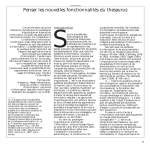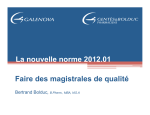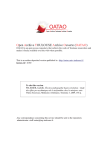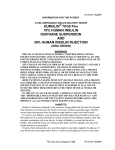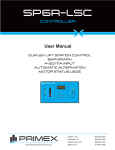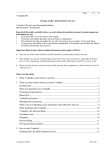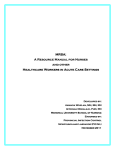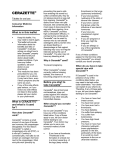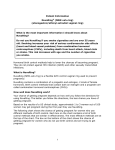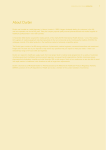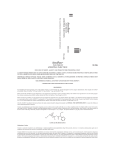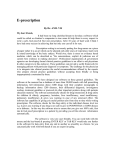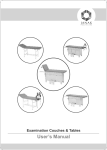Download Breast And Nipple Thrush - Pdf
Transcript
Policy, Guideline and Procedure Manual Breast and Nipple Thrush 1. Purpose This guideline provides details for the diagnosis and management of women with breast and nipple thrush (candida) at the Women’s. This guideline/procedure is related to Breastfeeding Policy 2. Definitions Breast and nipple thrush is the over-growth of candida albicans, on the nipples and in breast ducts, which can cause significant breast and nipple pain. 3. Responsibilities Maternity and neonatal medical, nursing and midwifery staff need awareness of the condition and to refer women to appropriate care. Lactation consultants and medical staff should be aware of the guideline and be able to treat accordingly. 4. Guideline 4.1 Breast and nipple thrush diagnosis The diagnosis of breast or nipple thrush is usually made after consideration of the mother’s symptoms; for example, mother may complain of ‘nipple pain’ that does not resolve despite improved attachment of the baby to the breast. The pain of maternal thrush infections may lead to early weaning, which can be avoided with early diagnosis and treatment. There may be a history of antibiotic treatment preceding thrush symptoms. This may have been prescribed postnatally, for example, to prevent infection following a caesarean section birth or for mastitis. The mother may have a past history of vaginal thrush. Nipple trauma commonly precedes nipple thrush symptoms. It is assumed that the break in the skin allows organisms to enter. 4.2 Signs and symptoms Nipple/areola • Mother may describe burning, stinging nipple pain which continues during and after the feed. • The nipples are often very tender to touch and even light clothing can cause pain • Nipples may appear pink and/or shiny and areola may be reddened, dry or slightly flaky. • Consider dermatitis if significant itching and or rash. Refer to RWH guideline: Nipple Eczema Dermatitis • If nipple pain is exacerbated by cold and/or nipples blanch consider nipple vasospasm. Refer to guideline: Nipple and Breast pain in Lactation which includes algorithm. Breast • Mother may describe shooting, stabbing, or deep aching breast pain. Pain may also be felt radiating into the back or down the arm. The breast pain typically occurs after feeding or expressing. The let-down reflex may be more painful than normal. • The pain may be localized to one nipple or breast or may be bilateral. • Breasts will appear normal. If inflamed, consider mastitis. Refer to guideline: Mastitis and Breast Abscess Baby • The baby may have signs of thrush such as white oral plaques in the mouth (tongue and inside cheeks) or red papular rash with satellite lesions around the anus and genitals. Although these signs are not always present, it should be assumed that the baby is colonised with the organism if the mother has evidence of nipple thrush. Uncontrolled document when printed Publication date (05/06/2013) Page 1 of 6 Policy, Guideline and Procedure Manual Breast and Nipple Thrush Once diagnosis of nipple and or breast thrush has been made then both mother and baby should be treated at the same time to prevent re-infection. 4.3 Treatment Baby Baby's mouth: Use miconazole oral gel (Miconazole Oral Gel (Daktarin®) 4 times a day for 1 week, then once daily for 1 week after signs/symptoms resolve. Use the spoon to measure a ¼ teaspoon dose. The spoon should not be used for administering the gel. Using a clean finger, apply small amounts of gel at a time to the inside cheeks and over the tongue. Note: In May 2006, Janssen-Cilag (the manufacturers of Daktarin gel) issued an alert advising pharmacists not to supply Daktarin (miconazole) oral gel for use in infants less than 6 months of age. This alert originates from concerns regarding the administration of the gel, not the medication itself. Health care providers must ensure, when recommending this product, that the client understands how to administer the product safely (see administration above). If the client/ mother is unsure about how to use the gel or is unable to purchase the product from her pharmacy, she can be advised to try another pharmacy or to use Nilstat oral drops (see below). However, it should be noted that the drops are not as effective for oral thrush in infants as the gel. Mother Topical • Nipple treatment for mother: miconazole oral gel/cream or nystatin cream applied to nipples after each feed (or 3-4 hourly during the day). It is not necessary to wipe the gel/cream from the nipples before the next breastfeed. Oral • If nipple pain only, fluconazole 150 mg capsules, one capsule every second day for 3 doses, followed by course of oral nystatin (quantity prescribed: 50) 2 tablets/capsules 3 times per day preferably with food. • If nipple pain persists, consider a further course of fluconazole 150mg capsules, either one capsule every second day for 3 doses or one capsule daily up to 10 days (available only on private prescription), followed by a further course of oral nystatin (2 tablets/capsules 3 times per day preferably with food (quantity prescribed: 50); • If nipple AND breast pain, fluconazole 150 mg capsules, one capsule every second day for 3 doses, plus a repeat prescription for a further course of fluconazole. If pain is not significantly reduced after the first 3 fluconazole capsules, followed by course of oral nystatin (2 tablets/capsules 3 times per day preferably with food (quantity prescribed: 50); then the repeat prescription of fluconazole should be filled to have another course of 150mg fluconazole every second day for 3 doses, followed by course of oral nystatin (2 tablets/capsules 3 times per day preferably with food (quantity prescribed: 50). See Appendix: Candida guide in nipple and breast pain (algorithm) If breast pain not resolving • If breast pain does not respond to fluconazole reconsider the diagnosis or consider oral ketoconazole (as the infection may be caused by non-albicans candida which may be resistant to fluconazole). If nipple pain is not resolving: • Consider gentian violet 0.5% aqueous paint applied after breastfeeding twice a day for up to 7 days (gentian paint is made up by pharmacy departments -RWH & Monash Medical Centre). See Appendix: Candida guide in nipple and breast pain (algorithm) Miconazole oral gel (Miconazole Oral Gel (Daktarin®) Miconazole oral gel is an antifungal agent with poor oral absorption (~25 - 30%). When applied topically onto the nipples, miconazole has minimal systemic absorption (0.1%). The first line treatment of nipple thrush is direct application of gel to nipples and to baby's mouth. Uncontrolled document when printed Publication date (05/06/2013) Page 2 of 6 Policy, Guideline and Procedure Manual Breast and Nipple Thrush Possible side effects and drug interactions of miconazole gel Mother: gel may irritate skin; if irritation occurs, cease using gel. Consider changing to miconazole cream or nystatin cream. It is not necessary to wipe the cream from the nipples before the next breastfeed. Baby: may cause some babies to gag or vomit. Consider changing to nystatin oral drops - apply 1mL in buccal cavity four times per day. Miconazole interacts with many drugs, such as warfarin, oral sulfonylureas, calcium channel blockers, phenytoin. Nystatin (Nilstat®, Mycostatin®) Nystatin is an antifungal agent used in the treatment of thrush (candidiasis) and is available as topical preparations and oral preparations such as tablets or capsules. Oral absorption is poor with undetectable plasma levels following oral doses. Dose: Nystatin drops: (brand names: Nilstat , Mycostatin, N-statin) Baby - apply 1mL to mouth four times a day for one week then once a day. Nystatin topical cream: (brand names Nilstat , Mycostatin ) Nipples - apply after feeds (at least 4 times a day). Nystatin tablets or capsules: 500,000 units Oral (mother) - 2 tablets/capsules three times a day (preferably with food) for a course of 50 tablets Possible side effects of nystatin: Mother - bad taste in mouth, diarrhoea, nausea, vomiting Baby - None reported (commonly used in infants) Possible drug interactions: None noted Fluconazole (Diflucan®) Fluconazole is an antifungal agent commonly used for systemic candida infections. Oral absorption is high at >90%, with peak plasma concentration occur in 1 - 2 hours after the dose. Plasma half-life = 30 hours. Dose: See under 4.2 Treatment Possible side effects and drug interactions of fluconazole Mother - Fluconazole is generally very well tolerated. Reported side effects include: vomiting, diarrhoea, abdominal pain and skin rashes. Baby - No complications have been reported from exposure via breastmilk. Cyclosporin, zidovudine, rifabutin, theophylline, oral hypoglycemics, warfarin, phenytoin and terfenadine can decrease hepatic clearance of fluconazole. Rifampin and cimetidine can reduce fluconazole plasma level (See product information for further detail). Gentian Violet 0.5% Paint Gentian violet is a topical antifungal and antibacterial agent. It is effective against fungi (such as Candida species) and bacteria (such as Staphylococcus species). Currently, gentian violet has a place in the treatment of nipple thrush when other treatment options have failed. Use of gentian violet: Available as a 0.5% aqueous paint. A prescription is required for this preparation and can be made up in some pharmacies on request. E.g. Royal Women's Hospital, Monash Medical Centre and compounding pharmacies. This paint is applied twice a day to the nipples using a cotton bud. Breastfeed the baby before each application. The recommended duration is a few days and should not be used for longer than 7 days. Uncontrolled document when printed Publication date (05/06/2013) Page 3 of 6 Policy, Guideline and Procedure Manual Breast and Nipple Thrush Contra-indications for use: • Hypersensitivity to gentian violet • On ulcerative lesions, open or broken wounds • In patients with porphyria • Opthalmic use Note: Gentian violet is a purple dye and may stain any material it comes into contact with eg: bathroom basin, clothing. Side effects: Gentian violet is generally well tolerated, however side effects have been reported: • Temporary staining of the skin and clothing • Overuse can result in gentian violet present in baby's mouth and consequently can cause ulceration of the mouth and throat • Skin irritation such as contact dermatitis. Concerns Gentian violet use is restricted to application to unbroken skin because of concerns about carcinogenicity and mutagenicity effects shown in animal studies. This research involves rats and mice that were fed large quantities of gentian violet over a period of time. An increased rate of cancer was found to have occurred in these animals. This has not been reported when used on the skin in humans but its use should be limited to nipples where other antifungal treatments have failed. Important: Store in a safe place away from children and discard after 2 weeks. 5. Evaluation, monitoring and reporting of compliance to this guideline Compliance to this guideline or procedure will be monitored, evaluated and reported through review of clinical practice in the Breastfeeding Service. All guidelines or procedures must have compliance measures developed and implemented. 6. References 1. 2. 3. 4. Moorhead AM, Amir LH, O'Brien PW, Wong S: A prospective study of fluconazole treatment for breast and nipple thrush. Breastfeed Rev 2011, 19(3):25-29. Richter SS, Galask RP, Messer SA, Hollis RJ, Diekema DJ, Pfaller MA: Antifungal susceptibilities of Candida species causing vulvovaginitis and epidemiology of recurrent cases. J Clin Microbiol 2005, 43(5):2155-2162. Walker M: Maternal Pathology: Breast and Nipple Issues. In: Breastfeeding Management for the Clinician: Using the Evidence. 2nd edn. Sudbury, Massachusetts: Jones and Bartlett Publishers; 2011. Wiener S. Diagnosis and management of Candida of the nipple and breast. J Midwifery Womens Health. 2006 Mar-Apr;51(2):125-8. 7. Legislation/Regulations related to this guideline Not applicable. 8. Appendices Appendix 1: Candida Guide in Nipple or Breast (Algorithm) Uncontrolled document when printed Publication date (05/06/2013) Page 4 of 6 Policy, Guideline and Procedure Manual Breast and Nipple Thrush PGP Disclaimer Statement The Royal Women's Hospital Clinical Guidelines present statements of 'Best Practice' based on thorough evaluation of evidence and are intended for health professionals only. For practitioners outside the Women’s this material is made available in good faith as a resource for use by health professionals to draw on in developing their own protocols, guided by published medical evidence. In doing so, practitioners should themselves be familiar with the literature and make their own interpretations of it. Whilst appreciable care has been taken in the preparation of clinical guidelines which appear on this web page, the Royal Women's Hospital provides these as a service only and does not warrant the accuracy of these guidelines. Any representation implied or expressed concerning the efficacy, appropriateness or suitability of any treatment or product is expressly negated In view of the possibility of human error and / or advances in medical knowledge, the Royal Women's Hospital cannot and does not warrant that the information contained in the guidelines is in every respect accurate or complete. Accordingly, the Royal Women's Hospital will not be held responsible or liable for any errors or omissions that may be found in any of the information at this site. You are encouraged to consult other sources in order to confirm the information contained in any of the guidelines and, in the event that medical treatment is required, to take professional, expert advice from a legally qualified and appropriately experienced medical practitioner. NOTE: Care should be taken when printing any clinical guideline from this site. Updates to these guidelines will take place as necessary. It is therefore advised that regular visits to this site will be needed to access the most current version of these guidelines. Uncontrolled document when printed Publication date (05/06/2013) Page 5 of 6 Appendix 1 Candida Guide in Nipple or Breast (Algorithm) Candida guide in nipple and breast pain (algorithm) For women with likely diagnosis of nipple/breast Candida (stinging, burning, nipple pain, shooting, radiating intermittent breast pain) Initial treatment Baby Mother Nipple pain only Miconazole oral gel four times a day for 1 week then once daily for one week. Other measures Nipple and breast pain Fluconazole 150 mg capsules nd every 2 day (3 doses) with a repeat prescription for nd fluconazole 150 mg every 2 day (3 doses) followed by Nystatin tablets 500,000units x2, three times a day and Miconazole oral gel to nipples x4 times a day. Fluconazole 150 mg nd capsules every 2 day ( X3 doses) followed by Nystatin 500,000 units x2, three times a day and Miconazole oral gel to nipples x4 times a day. Hygiene Wash hands frequently Wash towels daily Boil dummy daily and replace weekly if possible (if using). Review in one week YES: Complete treatment including Nystatin Is pain improving? NO NO: Breast pain not resolving: Consider a further course of fluconazole 150mg capsules, either one capsule every second day for 3 doses or one capsule daily up to 10 days YES NO: Nipple pain is not resolving: Consider gentian violet 0.5% aqueous paint applied after breastfeeding twice a day for up to 7 day. NO: Breast pain not resolving after further course of fluconazole: Reconsider the diagnosis or consider oral ketoconazole (as the infection may be caused by non-albicans candida which may be resistant to fluconazole). Uncontrolled document when printed Publication date (05/06/2013) Page 6 of 6






